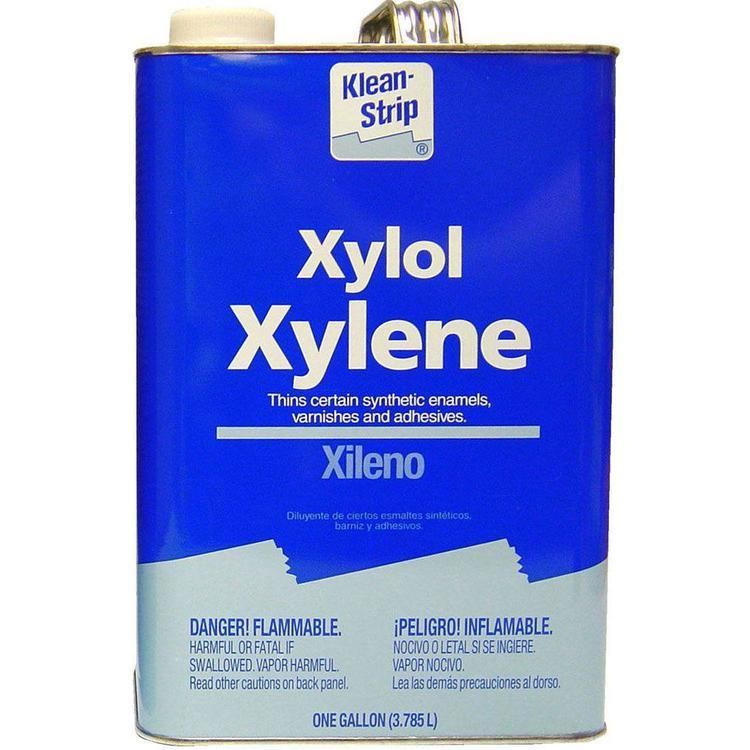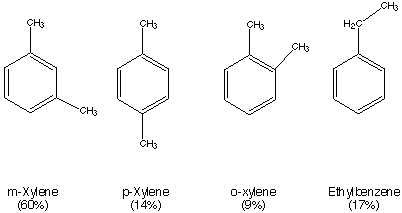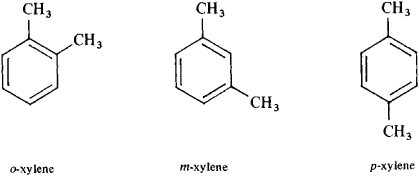Formula C8H10 | Molar mass 106.16 g/mol | |
 | ||
Aromatic 1e position isomers of dimethylbenzene xylene
Xylene (from Greek ξύλο, xylo, "wood"), xylol or dimethylbenzene is any one of three isomers of dimethylbenzene, or a combination thereof. With the formula (CH3)2C6H4, each of the three compounds has a central benzene ring with two methyl groups attached at substituents. They are all colorless, flammable liquids, some of which are of great industrial value. The mixture is referred to as both xylene and, more precisely, xylenes.
Contents
- Aromatic 1e position isomers of dimethylbenzene xylene
- Xylene plastic acid
- Occurrence and production
- History
- Isomers
- Industrial production
- Properties
- Terephthalic acid and related derivatives
- Solvent applications and industrial purposes
- Laboratory use
- Precursor to other compounds
- Safety
- References

Xylene plastic acid
Occurrence and production

Xylenes are an important petrochemical produced by catalytic reforming and also by coal carbonisation in the manufacture of coke fuel. They also occur in crude oil in concentrations of about 0.5–1%, depending on the source. Small quantities occur in gasoline and aircraft fuels.

Xylenes are produced mainly as part of the BTX aromatics (benzene, toluene, and xylenes) extracted from the product of catalytic reforming known as "reformate". The xylene mixture is a slightly greasy, colorless liquid commonly encountered as a solvent.

Several million tons are produced annually. In 2011, a global consortium began construction of one of the world’s largest xylene plants in Singapore.
History
Xylene was first isolated and named in 1850 by the French chemist Auguste Cahours (1813–1891), having been discovered as a constituent of wood tar.
Isomers
Xylene exists in three isomeric forms. The isomers can be distinguished by the designations ortho- (o-), meta- (m-), and para- (p-), which specify to which carbon atoms (of the benzene ring) the two methyl groups are attached. By counting the carbon atoms around the ring starting from one of the ring carbons bonded to a methyl group, and counting towards the second methyl group, the o-isomer has the IUPAC name of 1,2-dimethylbenzene, the m-isomer is 1,3-dimethylbenzene, and the p-isomer is 1,4-dimethylbenzene. Of the three isomers, the p-isomer is the most industrially sought after since it can be oxidized to terephthalic acid.
Industrial production
Xylenes are produced by the methylation of toluene and benzene. Commercial or laboratory grade xylene produced usually contains about 40-65% of m-xylene and up to 20% each of o-xylene, p-xylene and ethylbenzene. The ratio of isomers can be shifted to favor the highly valued p-xylene via the patented UOP-Isomar process or by transalkylation of xylene with itself or trimethylbenzene. These conversions are catalyzed by zeolites.
Properties
The chemical and physical properties of xylene differ according to the respective isomers. The melting point ranges from −47.87 °C (−54.17 °F) (m-xylene) to 13.26 °C (55.87 °F) (p-xylene). The boiling point for each isomer is around 140 °C (284 °F). The density of each isomer is around 0.87 g/mL (7.26 lb/U.S. gallon or 8.72 lb/imp gallon) and thus is less dense than water. Xylene in air can be smelled at concentrations as low as 0.08 to 3.7 ppm (parts of xylene per million parts of air) and can be tasted in water at 0.53 to 1.8 ppm.
Xylenes form azeotropes with water and a variety of alcohols. With water the azeotrope consists of 60% xylenes and boils at 94.5 °C. As with many alkylbenzene compounds, xylenes form complexes with various halocarbons. The complexes of different isomers often have dramatically different properties from each other.
Terephthalic acid and related derivatives
p-Xylene is the principal precursor to terephthalic acid and dimethyl terephthalate, both monomers used in the production of polyethylene terephthalate (PET) plastic bottles and polyester clothing. 98% of p-xylene production, and half of all xylenes produced is consumed in this manner. o-Xylene is an important precursor to phthalic anhydride. The demand for isophthalic acid is relatively modest so m-xylene is rarely sought (and hence the utility of its conversion to the o- and p-isomers).
Solvent applications and industrial purposes
Xylene is used as a solvent. In this application, with a mixture of isomers, it is often referred to as xylenes or xylol. Solvent xylene often contains a small percentage of ethylbenzene. Like the individual isomers, the mixture is colorless, sweet-smelling, and highly flammable. Areas of application include the printing, rubber, and leather industries. It is a common component of ink, rubber, and adhesives. In thinning paints and varnishes, it can be substituted for toluene where slower drying is desired, and thus is used by conservators of art objects in solubility testing. Similarly it is a cleaning agent, e.g., for steel, silicon wafers, and integrated circuits. In dentistry, xylene can be used to dissolve gutta percha, a material used for endodontics (root canal treatments). In the petroleum industry, xylene is also a frequent component of paraffin solvents, used when the tubing becomes clogged with paraffin wax. For similar reasons, it is often the active ingredient in commercial products for ear wax (cerumen) removal.(1)
Laboratory use
Xylene is used in the laboratory to make baths with dry ice to cool reaction vessels, and as a solvent to remove synthetic immersion oil from the microscope objective in light microscopy. In histology, xylene is the most widely used clearing agent. Xylene is used to remove paraffin from dried microscope slides prior to staining. After staining, microscope slides are put in xylene prior to mounting with a coverslip.
Precursor to other compounds
Although conversion to terephthalic acid is the dominant chemical conversion, xylenes are precursors to other chemical compounds. For instance chlorination of both methyl groups gives the corresponding xylene dichlorides (bis(chloromethyl)benzenes) whilst mono-bromination yields xylyl bromide, a tear gas agent used in World War I.
Safety
Xylene is flammable but of modest acute toxicity, with LD50 ranges from 200 to 5000 mg/kg for animals. Oral LD50 for rats is 4300 mg/kg. The principal mechanism of detoxification is oxidation to methylbenzoic acid and hydroxylation to hydroxylene.
The main effect of inhaling xylene vapor is depression of the central nervous system (CNS), with symptoms such as headache, dizziness, nausea and vomiting. At an exposure of 100 ppm, one may experience nausea or a headache. At an exposure between 200-500 ppm, symptoms can include feeling "high", dizziness, weakness, irritability, vomiting, slowed reaction time.
The side effects of exposure to low concentrations of xylene (< 200 ppm) are reversible and do not cause permanent damage.
One report contained data that shows that long-term exposure to low levels of xylene led to a decrease in balance, coordination, and reaction times in participants. These are examples of how it affects the CNS.
Long-term exposure may lead to headaches, irritability, depression, insomnia, agitation, extreme tiredness, tremors, impaired concentration and short-term memory. This condition is sometimes generally referred to as "organic solvent syndrome". Unfortunately, there is very little information available that isolates xylene from other solvent exposures in the examination of these effects.
Xylene is also a skin irritant and strips the skin of its oils, making it more permeable to other chemicals.
To reduce the risk of developing health problems from occupational exposure, one must wear gloves and a mask to prevent high concentrations of inhalation and skin irritation from Xylene.
